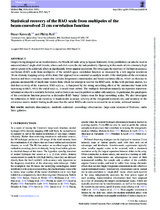Statistical recovery of the BAO scale from multipoles of the beam-convolved 21 cm correlation function
Abstract
Despite being designed as an interferometer, theMeerKAT radio array (a Square Kilometre Array pathfinder) can also be used in
autocorrelation (‘single-dish’) mode, where each dish scans the sky independently. Operating in this mode allows extremely high
survey speeds to be achieved, albeit at significantly lower angular resolution. We investigate the recovery of the baryon acoustic
oscillation (BAO) scale from multipoles of the redshift-space correlation function as measured by a low angular resolution
21 cm intensity mapping survey of this kind. Our approach is to construct an analytic model of the multipoles of the correlation
function and their covariance matrix that includes foreground contamination and beam resolution effects, which we then use to
generate an ensemble of mock data vectors from which we attempt to recover the BAO scale. In line with previous studies, we
find that recovery of the transverse BAO scale is hampered by the strong smoothing effect of the instrumental beam with
increasing redshift, while the radial scale is much more robust. The multipole formalism naturally incorporates transverse
information when it is available however, and so there is no need to perform a radial-only analysis. In particular, the quadrupole
of the correlation function preserves a distinctive BAO ‘bump’ feature even for large smoothing scales. We also investigate
the robustness of BAO scale recovery to beam model accuracy, severity of the foreground removal cuts, and accuracy of the
covariance matrix model, finding in all cases that the radial BAO scale can be recovered in an accurate, unbiased manner.

